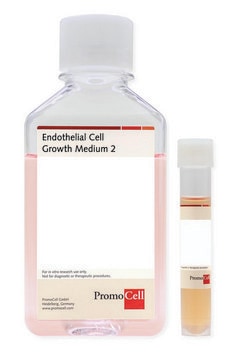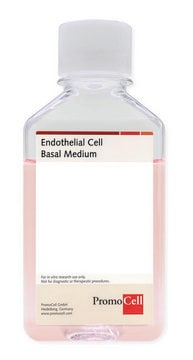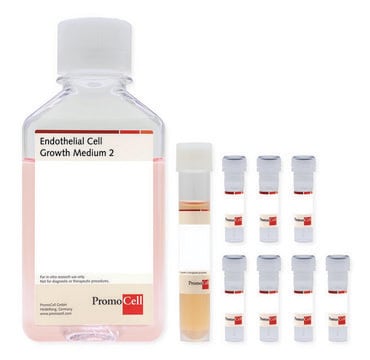This medium is a complete, ready-to-use product; no supplementation is required. This formulation contains hydrocortisone, heparin and other growth factors needed to support Endothelial Cell growth. Unless a suspension culture is required, the culture vessel should be tissue culture treated. The additional use of attachment matrices such as gelatin, would be dependent on the requirements of the specific cell line or type.
211-500
Endothelial Cell Growth Medium (500 ml)
Synonym(s):
Primary Cell Culture Media
Select a Size
€176.00
Select a Size
About This Item
€176.00
Recommended Products
form
liquid
Quality Level
shelf life
6 mo.
manufacturer/tradename
Cell Applications, Inc
shipped in
wet ice
storage temp.
2-8°C
General description
Application
Quality
Preparation Note
Storage Class Code
12 - Non Combustible Liquids
WGK
WGK 1
Flash Point(F)
Not applicable
Flash Point(C)
Not applicable
Choose from one of the most recent versions:
Certificates of Analysis (COA)
Don't see the Right Version?
If you require a particular version, you can look up a specific certificate by the Lot or Batch number.
Already Own This Product?
Find documentation for the products that you have recently purchased in the Document Library.
Customers Also Viewed
Articles
Medium 199 supports non-transformed cell cultivation in virology and vaccine production, offering broad species applicability.
Protocols
Technical information for working with human pulmonary artery endothelial cells including thawing, subculturing and cryopreservation
Technical information for working with human pulmonary artery endothelial cells including thawing, subculturing and cryopreservation
Technical information for working with human pulmonary artery endothelial cells including thawing, subculturing and cryopreservation
Technical information for working with human pulmonary artery endothelial cells including thawing, subculturing and cryopreservation
-
If I use this medium, do I need to use tissue coated treated flasks with gelatin? Does this medium need to be supplemented with heparin or is it already included?
1 answer-
Helpful?
-
-
Can you please provide the full composition of the medium with the concentrations?
1 answer-
This item is a product of Cell Applications. The formulation is considered proprietary. However, this medium does include glucose at 1g/L, 2% Fetal Bovine Serum, as well as Penicillin, streptomycin, and Amphotericin B. Some salt components have also been published in the Safety Data Sheet.
Helpful?
-
-
Do you sell glucose-free ECGM? I needed it for HUVEC cells. 0mM glucose.
1 answer-
This product is not a glucose-free medium. The formulation contains 5.78 mM glucose which is 5.55 mM after all the supplements are added. Unfortunately, a glucose-free ECGM medium is not currently offered.
Helpful?
-
Active Filters
Our team of scientists has experience in all areas of research including Life Science, Material Science, Chemical Synthesis, Chromatography, Analytical and many others.
Contact Technical Service






